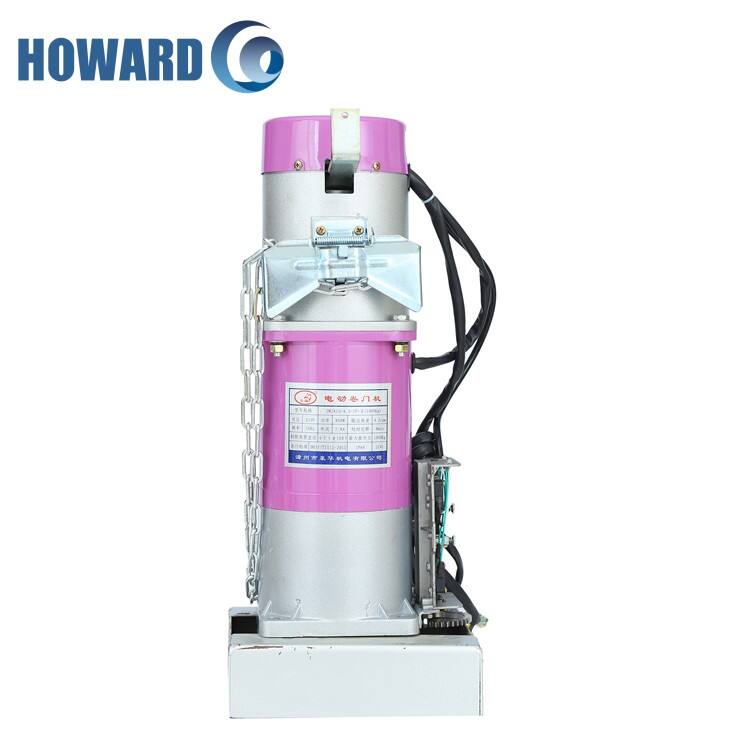Why Quiet Operation Matters in Residential Roller Door Motors
The growing demand for quiet and smooth garage door operation in modern homes
The way people live in cities and integrate smart tech into their homes has changed what homeowners look for when buying garage door motors. According to the latest Home Comfort Report from 2024, nearly seven out of ten buyers put quiet operation right at the top of their list. Garages aren't just storage areas anymore they're part of daily life now. That means loud garage door motors can really mess things up during important Zoom meetings, interrupt little ones' sleep time, or just generally annoy anyone coming home after midnight. Big name manufacturers are catching on fast, developing super quiet motors with nylon rollers and those fancy belt drive systems. These newer models cut down on noise caused by friction around 30% better than older parts, something most engineers working with industrial rollers will tell anyone who asks.
How low-noise roller door motors enhance home comfort and neighborhood harmony
Roller door motors that run under 55 decibels, roughly the same as someone talking normally, stop noise from traveling through shared walls in those townhouse and duplex setups. About 43 percent of houses have garages right next to sleeping areas or work spaces according to the National Housing Survey last year. When these quieter motors become standard, they actually get rid of what people call the "garage door curfew." Most folks just don't want to wake anyone up so they tend to wait until morning to open their doors. Quieter systems mean no more worrying about disturbing neighbors late at night.
Comparing decibel levels across motor types: Belt-drive, chain-drive, and screw-drive
| Motor Type | Average Noise Level | Peak Noise Events |
|---|---|---|
| Belt-drive | 55 dB | Door reversal (58 dB) |
| Chain-drive | 75 dB | Startup (82 dB) |
| Screw-drive | 65 dB | Cold weather (73 dB) |
Belt-drive systems dominate quiet residential installations, producing less noise than a dishwasher (60 dB). Their rubberized components absorb vibrations that amplify sound in chain-driven models.
The psychological benefits of consistent, silent roller door motor performance
A 2023 Stanford Behavioral Study found homeowners using silent roller door motors reported 22% lower stress levels during morning departures. The absence of mechanical grinding creates subconscious environmental cues of precision engineering and control—factors shown to increase perceived home value by 9% in real estate preference surveys.
Belt-Drive Motors: The Gold Standard for Quiet Roller Door Operation
Why belt-drive roller door motors lead in noise reduction and smooth performance
Residential garages mostly go for belt drive systems because they combine rubber belts with some pretty good engineering work. These motors don't make those annoying metal grinding noises that chain mechanisms do, plus they keep delivering steady power throughout operation. The newer tensioning tech helps stop belts from slipping around, which cuts down on vibrations during operation somewhere around three quarters less than what chain drives produce according to Garage Door Trends Report 2025. For folks living in houses where bedrooms sit right over the garage or walls are shared between spaces, belt drive motors really shine since they operate much quieter than other options.
DC motor technology: Powering quiet, energy-efficient belt-drive systems
Today's belt drive motors run on direct current (DC) tech which makes them super quiet, sitting well under 60 dB soundscape level. That's actually quieter than people talking normally in a room. These DC motors eat up around 30 percent less electricity compared to old school AC motors because they can adjust their power output based on how heavy the door is and how often it gets used throughout the day. Another neat feature? They come with soft start acceleration that stops those annoying jerky movements when starting up, so everything runs smoother and stays nice and quiet while operating.
Belt-drive vs. chain-drive: A performance and noise comparison for residential use
| Feature | Belt-Drive Motors | Chain-Drive Motors |
|---|---|---|
| Average Noise Output | 55-65 dB | 75-85 dB |
| Vibration Transmission | Rubber-dampened | Direct metal contact |
| Maintenance Frequency | Every 2-3 years | Annual lubrication |
| Peak Energy Efficiency | 92% | 78% |
Top-rated quiet roller door motors from leading manufacturers
The latest wave of motor technology brings together the proven durability of belt drives with modern smart home capabilities. Top brands now sell models equipped with self-adjusting torque settings, instant performance tracking through smartphone apps, and belts made from weatherproof materials that can handle over 20 thousand operation cycles before needing replacement. What makes these systems stand out is how they work with existing home automation setups. Homeowners can open and close garage doors using simple voice commands or set them to automatically respond when approaching the house, all while maintaining excellent noise reduction properties that traditional electric motors often lack.
Innovations Driving Silence: Technology Behind Modern Quiet Motors
Advancements in DC Motors and Variable Speed Control for Minimal Sound Output
Brushless DC tech is now commonly used in modern roller door motors because it helps cut down on mechanical friction, which is basically what causes all that annoying noise during operation. The newer systems come with variable speed controllers too. These controllers slowly increase power instead of just kicking in suddenly like old models did. No more sudden jerks or vibrations when opening or closing the door. The gradual acceleration makes these doors significantly quieter overall. Some tests show they can be up to 60 percent less noisy than traditional ones. Certain models run at under 55 decibels, which is actually quieter than most refrigerators hum away in kitchens according to research published last year in Noise Control Engineering Journal.
Vibration-Dampening Mounts and Precision-Engineered Gears for Silent Operation
Most top manufacturers these days install their motors on rubber mounts designed specifically to soak up those annoying vibrations before they ever reach the door frame. When paired with helical gears manufactured to extremely tight tolerances (we're talking micrometers here), the whole system cuts down on resonance frequencies quite significantly. Some studies in the industry have actually measured a reduction around 38%. What does all this mean for real world applications? Smoother operation across the board. Even the heavy duty models can keep noise levels below 60 decibels throughout thousands upon thousands of cycles without breaking a sweat. We've seen them last well past 10,000 operations while still performing like new.
Smart Integration: How Automated Controls Maintain Quiet Performance
IoT-enabled motors now self-adjust based on real-time conditions. Sensors monitor door weight distribution and environmental factors, dynamically optimizing motor torque through machine learning algorithms. This prevents unnecessary strain that could cause gear whine or belt slippage, while scheduling features ensure late-night operations use ultra-quiet “whisper modes” automatically.
Durability and Maintenance of Quiet Roller Door Motors
Long-Term Reliability of Belt-Drive Roller Door Motors Under Daily Use
Belt drive roller door motors typically last between 8 to 12 years when used regularly, which is about 40% longer than chain driven alternatives according to Ponemon's 2023 study. The steel reinforced belts combined with polymer gears stand up pretty well against daily wear and tear, even with 5 to 10 operations each day. What really makes these motors special though is their brushless DC design that gets rid of those pesky friction points found in older systems. Most manufacturers go the extra mile by applying military grade corrosion protection and building in torque limiting features. These little extras help protect against sudden mechanical stress when doors come to a stop unexpectedly, something that happens more often than people realize.
Build Quality and Material Standards in Leading Quiet Motor Brands
High quality quiet motors come with aluminum housings made through die casting processes and have IP54 protection against water and dust. They can handle pretty harsh conditions too, working fine even when temps drop below freezing down to about -22 degrees Fahrenheit or climb all the way up to 140 degrees. The real strength lies in those important parts such as axle bearings which get tested for around 50 thousand cycles before shipping out. This testing makes sure there's no direct metal touching metal inside the motor, something that happens a lot in lower priced alternatives and causes them to wear out faster over time. Safety standards matter a lot here too. Look for products certified by third parties like UL 325 because these checks confirm both safety features and good materials throughout. Also worth noting are the 16 gauge steel brackets used for mounting. These brackets spread out the load properly across surfaces, helping prevent any unnecessary strain on structures where the motor gets installed.
Maintenance Tips to Preserve Quiet Operation and Extend Motor Life
A bi-annual maintenance routine preserves silent performance:
- Lubricate nylon gears with silicone-based grease every 6 months
- Remove debris from tracks using compressed air monthly
- Tighten mounting hardware to 18–22 ft-lbs torque quarterly
Professional calibration every 3 years ensures alignment stays within 0.5mm tolerance, preventing vibration-induced noise. For optimal results, pair these practices with smart motor diagnostics that alert users to lubrication needs or belt tension changes via app notifications.
Installation and Compatibility: Choosing the Right Quiet Motor for Your Garage
Matching Quiet Roller Door Motors with Different Door Types and Sizes
Picking out the correct roller door motor involves finding that sweet spot between several factors including door weight, how the track is set up, and what kind of daily usage it will face. Most regular home doors around 7 to 8 feet high work pretty well with motors rated at 0.75 to 1.5 horsepower. But when dealing with bigger doors or ones that have insulation, folks generally need something stronger, like 1.25 HP or even more just so everything runs smoothly and quietly. Big name companies in the business create motors that come with adjustable rails which fit both those sectional style doors and the heavier rolling steel types too. Getting the alignment right makes quite a difference actually, cutting down on vibrations and noise levels by somewhere around 40 percent according to some tests. And if someone has one of those unusual setups where the door goes past 10 feet tall, there are special extension kits available with extra strong brackets that keep things stable without making too much noise during operation.
Professional vs. DIY Installation: Ensuring Optimal Performance and Safety
Many homeowners try their hand at installing things themselves to save money, but getting a pro on board really makes sure the motor gets calibrated right and stays within safety standards something that matters a lot when keeping things quiet around the house. When motors aren't aligned properly, they tend to get noisy fast often jumping up anywhere between 8 to 12 decibels because belts might be too tight or gears just aren't sitting where they should. Pros know exactly what to do here. They secure those special mounts that absorb vibrations and run tests on those automatic reversal systems that actually help cut down on noise caused by parts wearing out over time. With complicated installations, experts will typically perform torque tests and check alignments using infrared tools so everything moves smoothly without extra friction. Don't forget to look up what your local building codes say about this stuff either. Manufacturers are pretty strict about it too most folks don't realize that nearly three quarters of companies won't honor warranties if someone tried to install the motor themselves according to recent industry numbers from last year.
FAQ
Why is quiet operation important for residential roller door motors?
Quiet operation is crucial for maintaining peace in residential areas, preventing disturbances during activities like Zoom meetings or sleep, and enhancing daily comfort for homeowners.
What motor type is best for minimizing noise?
Belt-drive motors are preferred for their quiet operation, reducing noise better than chain or screw-drive motors by dampening vibrations more effectively.
How long do belt-drive motors typically last?
Belt-drive motors can last between 8 to 12 years with regular use due to their durable design using reinforced belts and polymer gears.
Can roller door motors be installed by homeowners themselves?
While possible, professional installation is recommended to ensure proper calibration, alignment, and adherence to safety standards, which also helps maintain quiet operation.
Table of Contents
-
Why Quiet Operation Matters in Residential Roller Door Motors
- The growing demand for quiet and smooth garage door operation in modern homes
- How low-noise roller door motors enhance home comfort and neighborhood harmony
- Comparing decibel levels across motor types: Belt-drive, chain-drive, and screw-drive
- The psychological benefits of consistent, silent roller door motor performance
- Belt-Drive Motors: The Gold Standard for Quiet Roller Door Operation
- Innovations Driving Silence: Technology Behind Modern Quiet Motors
- Durability and Maintenance of Quiet Roller Door Motors
- Installation and Compatibility: Choosing the Right Quiet Motor for Your Garage
- FAQ




